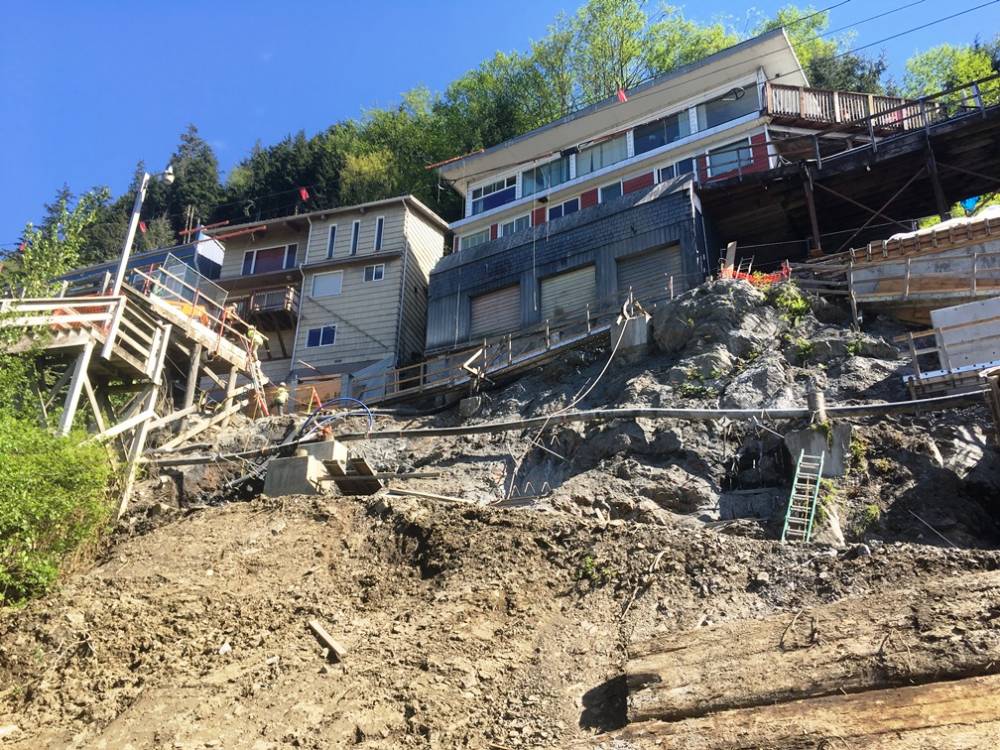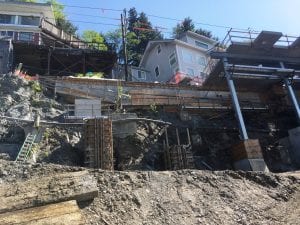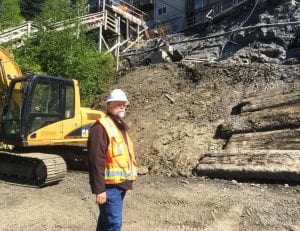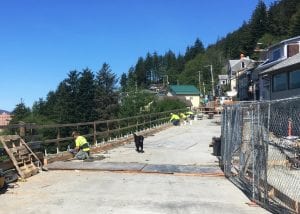
Houses on Upper Water Street bridge the gap between new construction and the old wooden trestle. Replacing the street’s trestle is an ongoing, multi-year project. (KRBD photo by Leila Kheiry)
Like many Southeast Alaska towns, much of Ketchikan is built on a hillside. An extreme example is Upper Water Street, where houses cling to a rocky cliff.
The narrow street leading to them is supported by pilings, but the wooden structure installed in the 1970s was deteriorating. Several years ago, the Alaska Department of Transportation worked with the City of Ketchikan to start a major upgrade on the narrow, high-altitude historic street. Here’s an update on how that work is progressing.
Audio PlayerA group of DOT officials and city employees in hard hats and reflective vests gathers at sea level on Tongass Avenue, to get a bottoms-up view of Upper Water Street.
Tipping our heads back far enough to get a good stretch, we see huge new concrete footings, and steel pilings supporting a concrete roadbed on one side. There’s a big scary gap between that and old, rickety wooden pilings on the unfinished side.

Concrete footings and steel pilings replace the timber trestle that formerly supported Ketchikan’s Upper Water Street. (KRBD photo by Leila Kheiry)
The gap has a precarious-looking footpath for construction crew members only. There also are a couple of homes just hanging there with no road, sidewalk or any real buffer between the house and open air.
“It’s very steep. Even walking some equipment up the hillside is a challenge,” said Aurah Landau, a spokeswoman for DOT. “It’s a very technically difficult project with not only doing sidewalks and bridge work and road construction, but relocating, redoing all the utilities up there: Water, sewer, power, telephone. It’s very, very complex.”
Which is why it’s taking a long time to complete. Project engineer John Scott said construction started in June of 2016. He said the biggest challenge has been the narrow working space.
“The overall width of the right-of-way is 25.5 feet. We have a little bit of temporary construction easement on either side,” he said. “So, as we move forward, we kind of have to do an inchworm effect where we take a big section, we build up, take a big section, we build up, so we minimize those impacts to people.”

The new portion of Upper Water Street is on the right, followed by a big gap. Residents of homes in the gap still have pedestrian access. (KRBD photo by Leila Kheiry)
Let’s get into those impacts just a bit, because even with efforts to minimize them, they’re still huge. It’s a pretty long street, and as we pointed out, up a hill, but with the narrow work space there was no way to allow any kind of parking for residents.
Landau said DOT rented a parking lot at the bottom of the hill for residents to use. That’s still a ways to walk, though.
“Especially in bad weather, it’s quite far from people’s homes,” she said. “So we provided a system of complimentary taxi rides, so residents could get around the construction zone to the designated car park.”
Landau said that Dawson Construction crews also maintained pedestrian access for affected homes.
One homeowner on Upper Water Street is Tracy Mettler. His house is one of the few that didn’t have access maintained. DOT simply relocated his whole family, including the cat and dog, for nearly a whole year. He got the call in May of 2016.
“They advised me that they’d be moving me due to noise and I needed to find a suitable house,” he said. “It’s May and it’s in Ketchikan.”

Project Engineer John Scott talks about ongoing work on Upper Water Street’s trestle replacement project. The old timber structure is seen in the background. (KRBD photo by Leila Kheiry)
Housing is tight in Ketchikan, especially in spring and summer because of all the seasonal, temporary workers.
Mettler said he did find a house on the North End, but then learned the state would not pay his extra fuel costs for driving much farther than usual to his job as a city firefighter, or extra rent fees for the family’s pets.
“The state doesn’t pay to relocate pets,” he said, laughing. “So, we started off kind of rough. But at the end of the day we were relocated into a house that was arguably nicer than the one we were in. Nice, quiet neighborhood. And now we’re back.”
When they got back, he said, he was able to drive to his house and park in a newly paved driveway. But, there were challenges getting to that point.
“At the beginning of the project, people called right-of-way agents came by,” he said. “They were giving away boxes of blue sky and happiness and promises about what they were going to be able to do once the project started.”
Mettler said those promises didn’t all pan out, but with some firm advocacy on his own behalf, he said, he was able to get the most important ones for his property.
Mettler agrees the Dawson crews are doing everything possible to help residents. But, he said, yeah, it’s still been a pain in the you-know-what.

Dawson Construction crew members work on the new section of Upper Water Street. A neighborhood dog checks out their progress. (KRBD photo by Leila Kheiry)
DOT acknowledges the inconvenience. But once it’s done, it should last a long time. Here’s project engineer John Scott again:
“The existing timber trestle was actually built in the late ‘70s, so it did last a long time,” he said. “Using that as a judge, this will last even longer.”
Scott added that all steel and concrete going into the structure is attached to the rock cliff with 12-foot bolts, so it’s solid. And there will be some nice upgrades. Where possible, formerly overhead utilities will go under the road, and there will be new water and sewer pipes throughout.
The end is in sight, but there’s still nearly a year to go. The estimated completion date is March of 2019. So residents of Upper Water Street will need to be patient a while longer.
Alaska Department of Transportation has numerous projects under way or in the planning stages for the Ketchikan area. Between now and 2020, DOT has about $200 million worth of projects slated for the city and borough.





